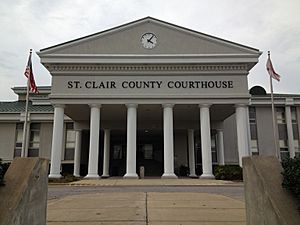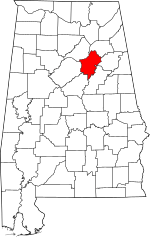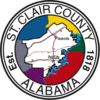St. Clair County, Alabama facts for kids
Quick facts for kids
St. Clair County
|
|||
|---|---|---|---|

St. Clair County Courthouse in Pell City
|
|||
|
|||

Location within the U.S. state of Alabama
|
|||
 Alabama's location within the U.S. |
|||
| Country | |||
| State | |||
| Founded | November 20, 1818 | ||
| Named for | Arthur St. Clair | ||
| Seat | Ashville & Pell City | ||
| Largest city | Moody | ||
| Area | |||
| • Total | 654 sq mi (1,690 km2) | ||
| • Land | 632 sq mi (1,640 km2) | ||
| • Water | 22 sq mi (60 km2) 3.3% | ||
| Population
(2020)
|
|||
| • Total | 91,103 | ||
| • Estimate
(2023)
|
95,552 |
||
| • Density | 139.30/sq mi (53.78/km2) | ||
| Time zone | UTC−6 (Central) | ||
| • Summer (DST) | UTC−5 (CDT) | ||
| Congressional district | 3rd | ||
|
|||
St. Clair County is a county located in the central portion of the U.S. state of Alabama. As of the 2020 census, the population was 91,103. It has two county seats: Ashville and Pell City. It is one of two counties in Alabama, and one of 33 in the United States, with more than one county seat. Its name is in honor of General Arthur St. Clair, an officer in the French and Indian War. St. Clair County is included in the Birmingham, Alabama Metropolitan Statistical Area.
Contents
History
St. Clair County was established on November 20, 1818, by the Alabama Territory legislature by splitting the area from Shelby County. The county seat was incorporated and named "Ashville" in honor of John Ash. In 1836, a portion of St. Clair County was separated to establish Cherokee County and DeKalb County. In 1866, after the Civil War, a northeast section of the county was used to create Etowah County.
Due to the relatively high terrain of the far southern end of the Appalachian Mountains which divides the county in a northeast–southwest orientation, and the difficulty of communication and administration from either side of the county to the other, a second county seat was established in Pell City to better provide administration and services to the southeast side of the county.
In 2019, St. Clair County became the seventh county in Alabama to adopt its own flag.
Geography
According to the United States Census Bureau, the county has a total area of 654 square miles (1,690 km2), of which 632 square miles (1,640 km2) is land and 22 square miles (57 km2) (3.3%) is water.
Adjacent counties
- Etowah County - northeast
- Calhoun County - east
- Talladega County - southeast
- Shelby County - southwest
- Jefferson County - west
- Blount County - northwest
Demographics
| Historical population | |||
|---|---|---|---|
| Census | Pop. | %± | |
| 1820 | 4,166 | — | |
| 1830 | 5,975 | 43.4% | |
| 1840 | 5,638 | −5.6% | |
| 1850 | 6,829 | 21.1% | |
| 1860 | 11,013 | 61.3% | |
| 1870 | 9,360 | −15.0% | |
| 1880 | 14,462 | 54.5% | |
| 1890 | 17,353 | 20.0% | |
| 1900 | 19,425 | 11.9% | |
| 1910 | 20,715 | 6.6% | |
| 1920 | 23,383 | 12.9% | |
| 1930 | 24,510 | 4.8% | |
| 1940 | 27,336 | 11.5% | |
| 1950 | 26,687 | −2.4% | |
| 1960 | 25,388 | −4.9% | |
| 1970 | 27,956 | 10.1% | |
| 1980 | 41,205 | 47.4% | |
| 1990 | 50,009 | 21.4% | |
| 2000 | 64,742 | 29.5% | |
| 2010 | 83,593 | 29.1% | |
| 2020 | 91,103 | 9.0% | |
| 2023 (est.) | 95,552 | 14.3% | |
| U.S. Decennial Census 1790–1960 1900–1990 1990–2000 2010–2020 |
|||
2020 census
| Race / Ethnicity (NH = Non-Hispanic) | Pop 2000 | Pop 2010 | Pop 2020 | % 2000 | % 2010 | % 2020 |
|---|---|---|---|---|---|---|
| White alone (NH) | 57,917 | 72,947 | 74,962 | 89.46% | 87.26% | 82.28% |
| Black or African American alone (NH) | 5,253 | 7,098 | 8,617 | 8.11% | 8.49% | 9.46% |
| Native American or Alaska Native alone (NH) | 233 | 252 | 249 | 0.36% | 0.30% | 0.27% |
| Asian alone (NH) | 108 | 512 | 655 | 0.17% | 0.61% | 0.72% |
| Pacific Islander alone (NH) | 17 | 41 | 20 | 0.03% | 0.05% | 0.02% |
| Other race alone (NH) | 16 | 64 | 234 | 0.02% | 0.08% | 0.26% |
| Mixed race or Multiracial (NH) | 512 | 963 | 3,791 | 0.79% | 1.15% | 4.16% |
| Hispanic or Latino (any race) | 686 | 1,716 | 2,575 | 1.06% | 2.05% | 2.83% |
| Total | 64,742 | 83,593 | 91,103 | 100.00% | 100.00% | 100.00% |
As of the census of 2020, there were 91,103 people, 32,829 households, and 25,409 families residing in the county.
2010 census
As of the census of 2010, there were 83,593 people, 31,624 households, and 23,364 families living in the county. The population density was 132 people per square mile (51 people/km2). There were 35,541 housing units at an average density of 56 units per square mile (22 units/km2). The racial makeup of the county was 88.2% White, 8.6% Black or African American, 0.3% Native American, 0.6% Asian, 0.1% Pacific Islander, 0.9% from other races, and 1.3% from two or more races. 2.1% of the population were Hispanic or Latino of any race. Of the 31,624 households 30.7% had children under the age of 18 living with them, 58.3% were married couples living together, 11.2% had a female householder with no husband present, and 26.1% were non-families. 22.5% of households were one person and 8.5% were one person aged 65 or older. The average household size was 2.58 and the average family size was 3.02.
The age distribution was 23.7% under the age of 18, 7.8% from 18 to 24, 27.8% from 25 to 44, 27.6% from 45 to 64, and 13.1% 65 or older. The median age was 38.6 years. For every 100 females, there were 100.5 males. For every 100 females age 18 and over, there were 102.3 males.
The median household income was $48,837 and the median family income was $56,107. Males had a median income of $43,287 versus $32,843 for females. The per capita income for the county was $22,192. About 8.3% of families and 10.6% of the population were below the poverty line, including 13.2% of those under age 18 and 9.5% of those age 65 or over.
Places of interest
St. Clair County is home to Logan Martin Lake. It also contains Horse Pens 40, a private outdoor park on top of Chandler Mountain.
Communities
Cities
- Ashville (county seat)
- Leeds (mostly in Jefferson County and Shelby County)
- Margaret
- Moody
- Pell City (county seat)
- Springville
- Trussville (mostly in Jefferson County)
Towns
- Argo (partly in Jefferson County)
- Odenville
- Ragland
- Riverside
- Steele
- Vincent (partly in Shelby County and Talladega County)
Unincorporated communities
- Acmar
- Cooks Springs
- Cropwell
- New London
- Pinedale Shores
- Prescott
- St. Clair Springs
- Wattsville
- Whitney
Former towns
- Branchville (now a neighborhood in Odenville)
Transportation
Major highways
 Interstate 20
Interstate 20 Interstate 59
Interstate 59 U.S. Route 11
U.S. Route 11 U.S. Route 78
U.S. Route 78 U.S. Route 231
U.S. Route 231 U.S. Route 411
U.S. Route 411 State Route 23
State Route 23 State Route 34
State Route 34 State Route 144
State Route 144 State Route 174
State Route 174
Rail
- Alabama and Tennessee River Railway
- Norfolk Southern Railway
Historically, the Southern Railway ran several daily passenger trains, including the Kansas City-Florida Special and an Atlanta-Birmingham section of the Piedmont Limited, making stops in Pell City. The Sunnyland made signal stops as well. The last trains made stops in 1967. Today, the nearest passenger service is Amtrak's Crescent in Anniston, 30.6 miles to the east.
See also
 In Spanish: Condado de St. Clair (Alabama) para niños
In Spanish: Condado de St. Clair (Alabama) para niños



